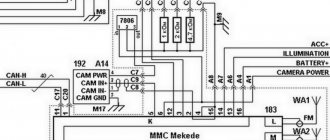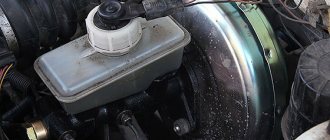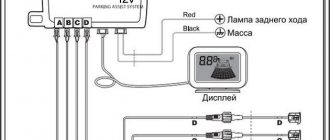Acoustic amplifier controls
The process of tuning a car amplifier involves changing parameters, each of which has a separate function. To configure even the simplest amplifier there are controls:
- So, Crossover Selector is nothing more than a filter switch.
- In the LP position, the amplifier operates in LPF (low pass filter) mode.
- When the regulator is set to the HP position, the operation is in high-pass filter mode.
- In the AP position, the filters are disabled and do not work.
In addition, there is a switch on the rear panel that controls the cutoff frequency of the filters. “Level” is a knob for adjusting the power level. And with the help of “Bass Boost” you can enhance low frequencies, but you shouldn’t try too hard.
If this is a high-power device, then before connecting the amplifier in the car, experts recommend installing a capacitor.
What types of subwoofers are there?
The characteristics of “subs” clearly show how they differ from conventional speakers:
- the frequency range has artificially established boundaries, usually this value is 40–200 Hz;
- the product is equipped with a large diameter sound emitter - for example, for a device for home use it ranges from 30 to 50 cm.
Subwoofers have a simple design, but are divided into several types: closed, open, active and passive.
- Passive. Their design is very simple. They have a low frequency filter and a large speaker. To “boost” such a device you will need an amplifier. The device is unable to process or convert the signal.
- Active. They do not require an additional amplifier to operate. A speaker and circuits for controlling filtering are built into the device body. The product is capable of processing and amplifying the audio signal supplied to it. It has a significant advantage - an active subwoofer is easy to install in an already prepared audio system.
- Closed. They have a durable body. Most often, closed-type subwoofers are passive subs. Such products provide good sound, do not distort the audio signal, and do not cause resonance or reverberation. However, they have their own drawback - the larger the diameter of the installed speaker, the greater the power required to “swing” its membrane.
- Open. This option is installed directly into the prepared car body, most often in the trunk. With this installation option, the device will use the entire volume of the cabin to create deep and rich bass. The disadvantage of such a “sub” is that it is quite difficult to achieve high-quality sound.
ATTENTION! When using filtering, the maximum frequency that an open-type product can achieve is 100 Hz.
Starting point for acoustic tuning
At the entry level, anything beyond adjusting crossovers and gain levels doesn't matter. In addition, it does not matter how the amplification part is implemented. The basic principle is always the same.
Here's how to set up the amplifier:
- To begin with, turn off any sound adjustment circuits.
- If this is not possible, then the correction is set to zero. It is worth remembering that this is not the same thing - in the first option, the signal will not go through the correction circuits. This means that its path will be shorter and the level of distortion will be lower.
- In passive crossovers, the RF control is set to approximately the average level, even if it is different from zero. You should select a value of -3 dB.
- In the case of active crossovers, the crossover frequency of the low-pass and high-pass filters is initially made the same. The level should be around 75-80 Hertz.
The gain level on any channels is set to the very minimum position. If all these conditions are met, then optimal basic settings can be achieved.
Now the car audio amplifier should be configured
There are usually several typical settings:
- Sensitivity level. On amplifiers it can be indicated as “level” or “Gain”.
- Low pass filter. LowFrequency or LPF. Cuts the upper frequency limit for the subwoofer.
- High pass filter. High Frequency or HPF. Cuts the lower frequency limit. Used when midrange and tweeter speakers are connected to the amplifier or these channels.
- Crossover or x-over, switch between low and high pass filters. Also has a third position when filters are not enabled (Full or Flat).
Setting up an amplifier for a car
- Set the sensitivity level to minimum (turn it counterclockwise until it stops).
- We turn on the head unit and turn up the volume level to the maximum (or almost maximum, until sound distortion appears), now smoothly turn the sensitivity control on the amplifier until noticeable noise and sound distortion appear, turn it down a little and leave it. Caution: May be very loud.
- We turn down the volume level on the head unit (radio tape recorder) to a normal level.
Category Audio equipment
materials in the category Subcategory Audio effects console circuits
The device can be used as a useful additional attachment to any stationary audio amplifier and allows, in the absence of a signal at the output load (speakers in speakers) for a time interval of more than 4 minutes, to automatically turn off the power to the radio equipment from the 220 V network, if you forget to do this yourself earlier.
Gain Setting
Setting the amplifier's input sensitivity is an important step. Any instructions for the amplifier will indicate how to adjust this coefficient. But in practice, you may find that the level is set incorrectly. In the most innocuous case, these errors can only lead to inconsistent sound. At worst, there will be significant distortion (perhaps even some system components will fail).
If the high-frequency speakers in the car are constantly on, the culprit is an incorrectly set gain. Subwoofers also burn, even if they are well and correctly matched in power to the amplifier. This sometimes happens to those who do not know how to set up the amplifier in the car and try to get everything out of the device. But high-quality sound does not have to be loud. The main parameter is its purity.
If the goal is not to achieve maximum volume, then the main thing in adjusting the gain is not to be greedy. There is no need to squeeze everything that it can out of the device. It is intended for other purposes. Speaker, amplifier - everything should sound clean. It’s better to make a little mistake and underestimate the coefficient. This will reduce the volume reserve, but the sound will be of higher quality. Considering the power reserve that most low-end amplifiers have, losses in maximum volume do not lead to quiet sound.
HPF / LPF (HPF / LPF)
Hight pass filter (HPF), also known as a high-pass filter (HPF), filters out (cuts off) low frequencies, leaving high ones.
When setting up a subwoofer amplifier, set the control to about 20 Hz to cut out infrasound and not waste energy, since you won't hear it anyway. For mid-range speakers, the HPF is set around 80 Hz to remove the low frequency range for which the speaker is not designed and will not be able to play it. If you have separate channels or even a separate amplifier for tweeters (tweeters), the HPF is set in the region of 3000 - 5000 Hz, depending on the model, so as not to burn them.
Setting up for working with a subwoofer
Let's use a simple example to see how to configure an amplifier for a subwoofer. Let it be connected to Rear on the amplifier, and the front speakers connected respectively to Front. Experts recommend the following settings:
- The bass boost is set to zero for both channels. The level or gain is also set to zero.
- The crossover for the Front channel is set to the HP position.
- For the Rear channel, the crossover is set to the LP position.
- Next, all that remains is to adjust the sensitivity by adjusting the gain so that the sound is as harmonious as possible. It can be adjusted for front and rear channels as desired.
Here's how to set up an amplifier for a subwoofer in practice. As you can see, there is nothing complicated about this. All you need is good hearing, acoustic tracks and enough free time.
There are several types of car audio amplifiers
- A two-channel amplifier for a car involves connecting two front or two rear speakers. Also used to connect a subwoofer. It is very rare to connect 4 speakers.
- A four-channel car audio amplifier allows you to connect two front and two rear speakers. Another option is possible: in two channels there are two speakers, and the other two channels are connected by a bridge to the subwoofer. In the case of a subwoofer, it is difficult to achieve good sound pressure. It is preferable to use two two-channel amplifiers.
- If the device is five-channel, four channels are for speakers, and the fifth is for the subwoofer. As in the previous option, when connecting a subwoofer, most of the amplifier's power will be used to reproduce low frequencies. It may not be enough for mid and high frequencies. A five-channel amplifier is a good option for listeners who are undemanding in terms of volume levels.
- Monoblock - an amplifier with one channel for a subwoofer.
On car amplifiers, connectors are grouped into groups depending on their purpose:
DIY setup without a subwoofer
In this case, the speaker system consists of four speakers. In this option, the settings will be the simplest. With this design, the amplifier filters are disabled. All parameters are set to zero, and the crossover selector is set to the “Flat” position. With these settings, the speaker, amplifier and all other components will produce high-quality sound without distortion.
All that remains is to expose the head unit. This can be done by selecting from ready-made equalizer settings. The volume is turned up to 90 percent and the track starts. During the sound process, the gain is adjusted until the sound is loud and clear, without distortion. This is how you can set up a simple amplifier for the average music lover.
Connecting the subwoofer
Most often we have to deal with subwoofers that are part of speaker systems of different configurations - 2.1, 5.1 or 7.1. Connecting such devices, since they are designed to work in conjunction with a computer or DVD player, usually does not cause difficulties. It is enough to determine which connector this or that type of speaker is connected to.
Difficulties begin when we try to turn on a subwoofer, which is a separate speaker purchased in a store or previously included in another speaker system. Some users are also interested in the question of how to use powerful car subwoofers at home. Below we will discuss all the connection nuances for different types of devices.
Setting up household amplifiers
The principles of adjusting home amplifiers are practically no different from the method described above. But there is an exception - if it is an amplifier and not a receiver, then it often has two channels and an equalizer.
First, everything is set to zero, and then the desired frequency response is adjusted by ear and taste on the equalizer. They also adjust the input sensitivity so that there is no distortion at the output.
Connectors for speaker systems (speakers or subwoofer).
The wires from the speakers are connected. It is important to connect the “+” and “-” contacts on the amplifier to the corresponding “+„, “-” contacts on the speakers. How to connect a subwoofer with a two-channel bridge? We connect one wire from the subwoofer to the positive terminal of one channel on the amplifier, and the second wire from the subwoofer to the negative terminal of another channel of the amplifier. We connect the free positive and negative terminals on the amplifiers with a short wire to each other (not required for all amplifiers, see the instructions).
Gain Level
Gain (sensitivity) is often confused with volume, but this is not entirely correct.
Gain is an adjustment of the amplifier's input sensitivity to match the radio. But let’s not get into the weeds and consider this setting from the point of view of what is useful for the user.
Sometimes the Volts (V) value indicated on the regulator can be misleading. The fact is that sensitivity is measured in Volts. The smaller V, the higher the sensitivity, the louder the speaker will play and vice versa.
To begin with, it will be useful to watch a clear video about how gain works on an amplifier:
Adjusting gain by ear (method 1)
Having a good sub link, do not use an equalizer and various bass enhancers, forget about bassboost on the amplifier - so before adjusting the gain, make sure that all this is turned off!
Set the control to minimum and play music that you usually listen to. Turn up the volume of the radio by 3/4 of the maximum; if you hear distortions in the sound of the subwoofer earlier, stop and turn down the volume a couple of notches. Go to the amplifier. Have an assistant slowly turn up the gain control until new distortion appears, and when you hear it, stop the rotation and turn it down by 10%.
Adjusting gain by ear (method 2)
If you don’t trust your hearing and are afraid not to hear changes during time, then use a more accurate method - using sinuses.
If you are tuning a subwoofer, then use 40 Hz, if your case is tuned above 40 Hz or you have a closed box, then take 50 Hz (download sines in the Downloads section). To set the gain for the midbass amp, use 315 Hz.
Sine or tone (in our case) is a tone signal of a certain frequency, changes in the sound of which you can easily hear
Set the gain to minimum, turn on your sine and turn up the volume of the radio. When changing the sound of the tone signal, stop and turn it down a couple of notches (set the maximum volume limit to this value if your radio has such a function). Go to the amplifier. Similarly to the first method, add gain. When the sound changes, stop and turn it down 10%.
Adjusting Gain Using a Multimeter or Oscilloscope
Adjusting the gain level using instruments is a smart and precise adjustment. At the same time, neither the speaker nor your ears are strained. This setup is shown in detail in the video on our YouTube channel:
Please note that when setting with a multimeter, you must be sure of the power declared by the amplifier manufacturer.











